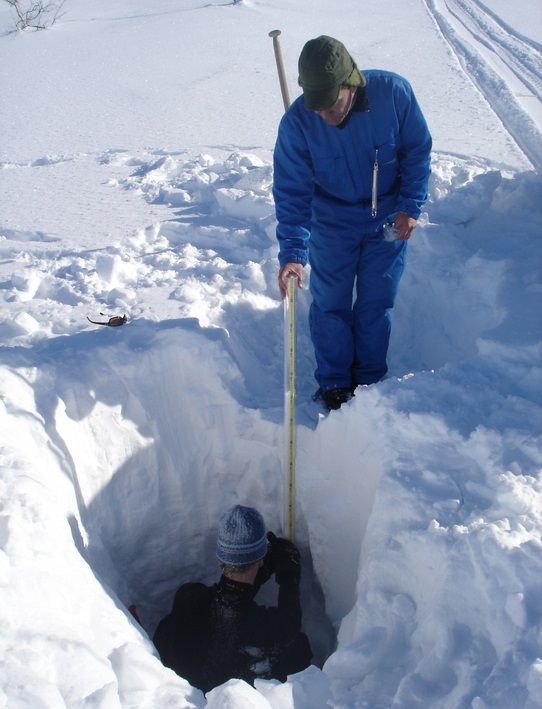A never-ending struggle – Improving spring melt runoff forecast via snow information
Contributed by David Gustafsson (SMHI), member of the SMHI Guest Columnist Team
As long as we can remember, the Swedish hydropower hydrologists have tried to improve the spring melt runoff predictions by integrating snow measurements in their forecast models. Various measurements techniques have been used: traditional snow surveys with snow tube sampling; snowmobile and helicopter borne ground-penetrating radar and gamma-ray sensors; laser-scanning; and of course numerous attempts with satellite data (Photo 1). The usual conclusions have been, “yes we can reduce the forecast error with this new snow data but … improvements were not systematic between sites and years, and also very small compared to average errors in the HBV model. So why putting an effort on including snow data when it only increases the overall uncertainty?”.
Photo 1. Snow water equivalent measurement in Jämtland, Sweden. (photo by D. Gustafsson)
Typically, the average forecast error is around 10-20% for the total spring melt runoff volume. In the latest attempt with assimilation of in-situ and satellite based snow information, we managed to show a reduction of volume errors from 20-30% to around 15-20%, corresponding to a relative improvement of some 20-30% (more details will be shown at the upcoming HEPEX workshop in Quebec!). Not so impressive maybe, but we raise the question “how does this compare to the actual economic value of the hydrological forecasts?”
The 2015 spring melt season was very interesting in Sweden. The winter was a typical NAO+ with more precipitation and higher temperatures than usual, resulting in unusually little snow at low altitudes in most part of the country and much more snow than usual at higher altitudes in the middle and northern part of Sweden. On top of that, the spring was rather cold and the snow melt season was extended long into the summer months. The forecast models also indicated much more snow than usual in the large important hydropower basins; consequently the experienced reservoir managers decided to increase power production during spring to empty the reservoirs as much as possible. They do this to avoid spilling of meltwater that should be used for the next winter – but they did not empty the reservoirs as much as the forecasts suggested, partly due to bad experience from the previous year with a similar situation, and partly due to limits in the production capacity. Despite their best efforts and expert knowledge on hydro-climatic forecasts, there was a lot of water spilled at the end of summer, when the reservoirs were already full while snow melt was still ongoing. In addition, the impact of their decision was amplified by the unusual amount of rainfall in the early summer. Of course, the large amount of snow was there in the forecast models, but this year instead, the snow melt timing and the additional rainfall during the snow melt season affected the forecast skill.
In the case where regulation was perfect and no water was lost, rough estimates by our hydropower users indicate that the economic value of the lost power production could have been in the order of 10-60 million SEK (roughly about 1-6 million Euros); note that this is only in one of the major rivers in Sweden – the Ume River which happens to be one of the test cases in the IMPREX project. So despite the small improvements over the past, it seems like that the never-ending struggle to improve snow melt forecasts with snow data will continue and could be motivated also from economic perspectives. However, this story also tells us that identifying the drivers of predictability should be one of the key elements to improve the hydrological forecasts and their use.
Special thanks to Björn Norell (Vattenregleringsföretagen AB) for estimates of water loss and economic values of potential power production.

May 20, 2016 at 02:36
Hi David, thank you. The story on forecast-informed hydropower scheduling is very interesting. It seems that in the last year, reservoir managers hedged against forecast uncertainty and did not release enough storage from the reservoir. Happy to learn the forecasts and decisions in this year.